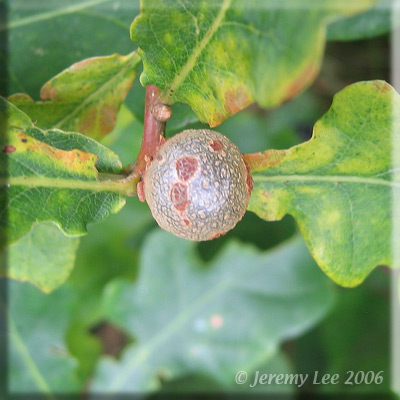
 |
|
Scientific Classifications explained » Amphibians » Ants » Aphids » Bees » Beetles » Birds » Bugs » Butterflies » Caterpillars » Damselflies » Dragonflies » Earwigs » Flies » Frog/Leafhoppers » Fungi » Galls » Grasshoppers » Harvestmen » Hoverflies » Lacewings » Ladybirds » Leaf Mines » Lichens » Mammals » Millipedes » Mosses » Moths » Sawflies » Slugs » Snails » Spiders » Trees » Wasps » Wild Flowers » Woodlice |
UK Nature > Galls > Oak Marble Gall

Gall causer: Andricus kollari Common Name: Oak Marble Gall These galls, on our traditional English oak, Quercus robur, are caused by a minute gall wasp, Andricus kollari. Formed in buds, they can grow up to about 25mm in diameter. The gall starts life green in colour, but changes to brown by the autumn, when the adult wasps emerge. With a length of 1.5 to 2mm, the male wasp is very dark brown to black on the head, has a hunched thorax and a black abdomen. The legs are yellowy brown and the antennae are a translucent yellow/brown colour. The female has a dark brown appearance overall. The gall is seen more often than the adult wasp. The empty gall, now showing a neat little hole in the side where the wasp emerged, remains on the twig. Like most gall wasps, the life cycle is complicated, with an alternation of a sexual and asexual generation each year. |
|

https://www.uknature.co.uk is a website dedicated to showing the immense diversity of UK nature and wildlife. Our vast range of habitats, from lowland arable to snow covered mountains, from storm-ravaged coastlines to peaceful inland freshwater lakes and rivers, from dry, sandy heaths to deciduous and coniferous forests, all these habitats contribute to the abundance of UK nature. We have wild birds in huge numbers either residing or visiting our shores (597 recorded species as at July 2013) and we must also not forget the humble back garden with its grass lawns, flower beds filled with nectar rich flowers, shrubs and trees, all designed to attract huge numbers of insects such as bees, moths, butterflies and hoverflies; and finally the small ponds which provide safe havens for frogs, toads, newts and even slow worms and grass snakes. www.uknature.co.uk is the showcase for my personal passion, photographing uknature in all its glory. I sincerely hope you all enjoy the fruits of my labours. This site and all images contained therein is © Jeremy Lee 2004 - 2021. All Rights Reserved. Site design by Jeremy Lee. Site development & IT Support by Stuart Lee. |